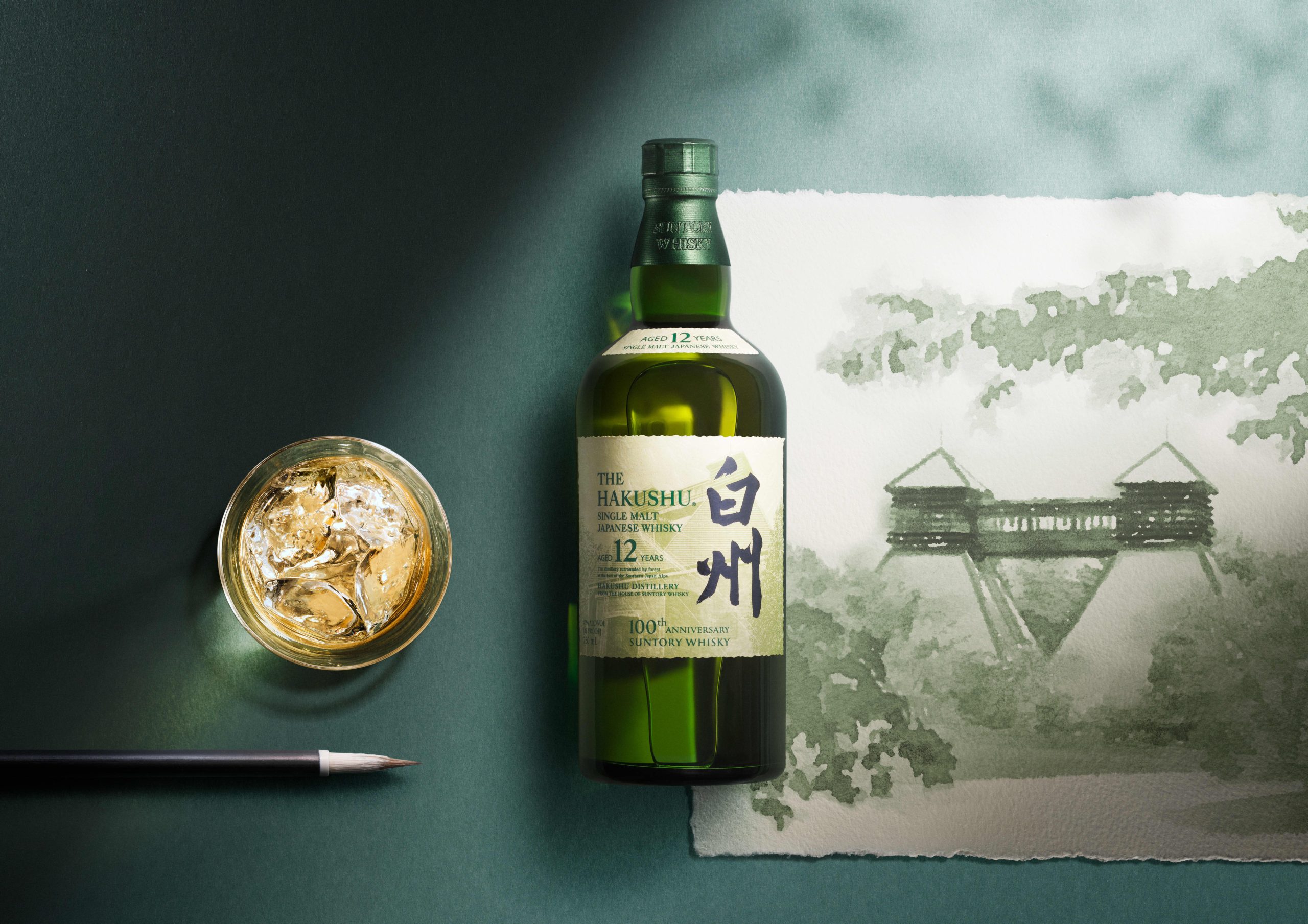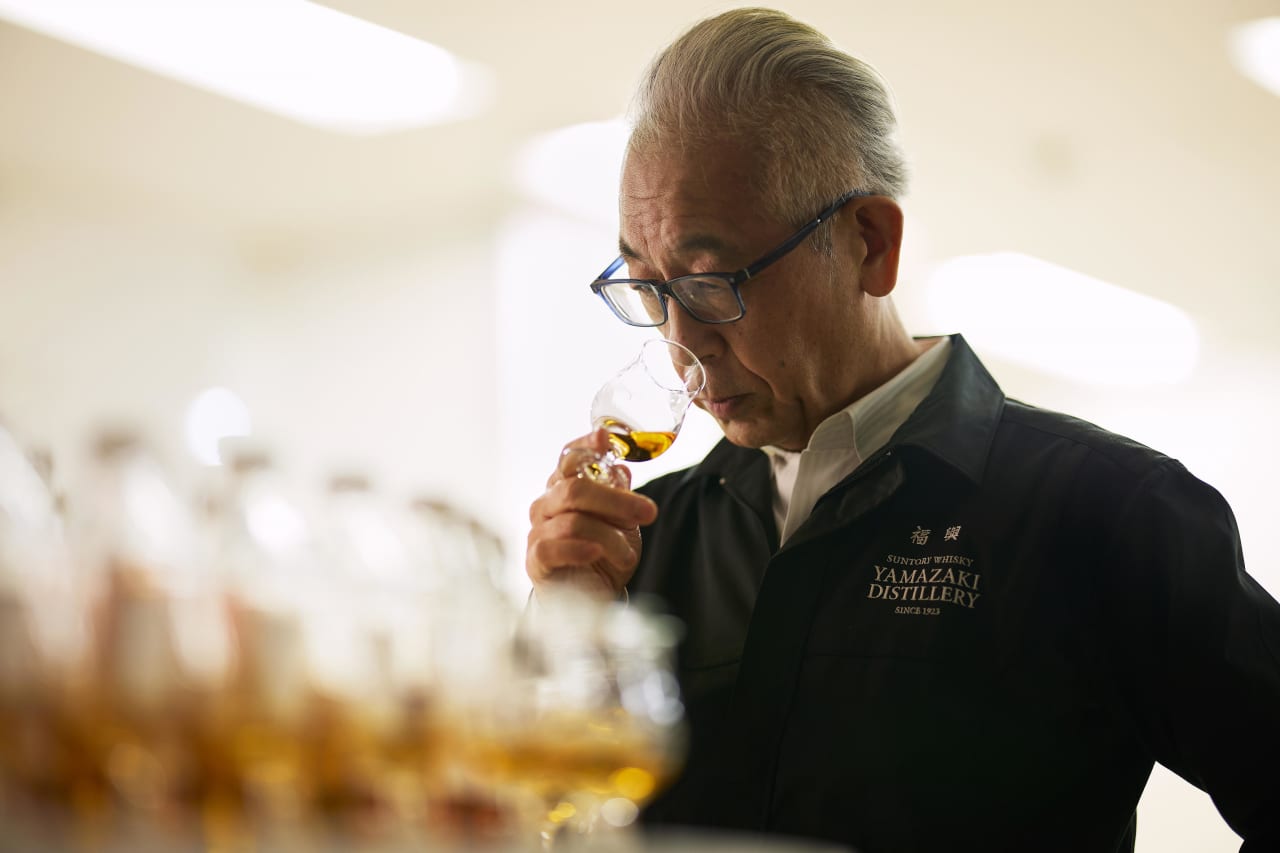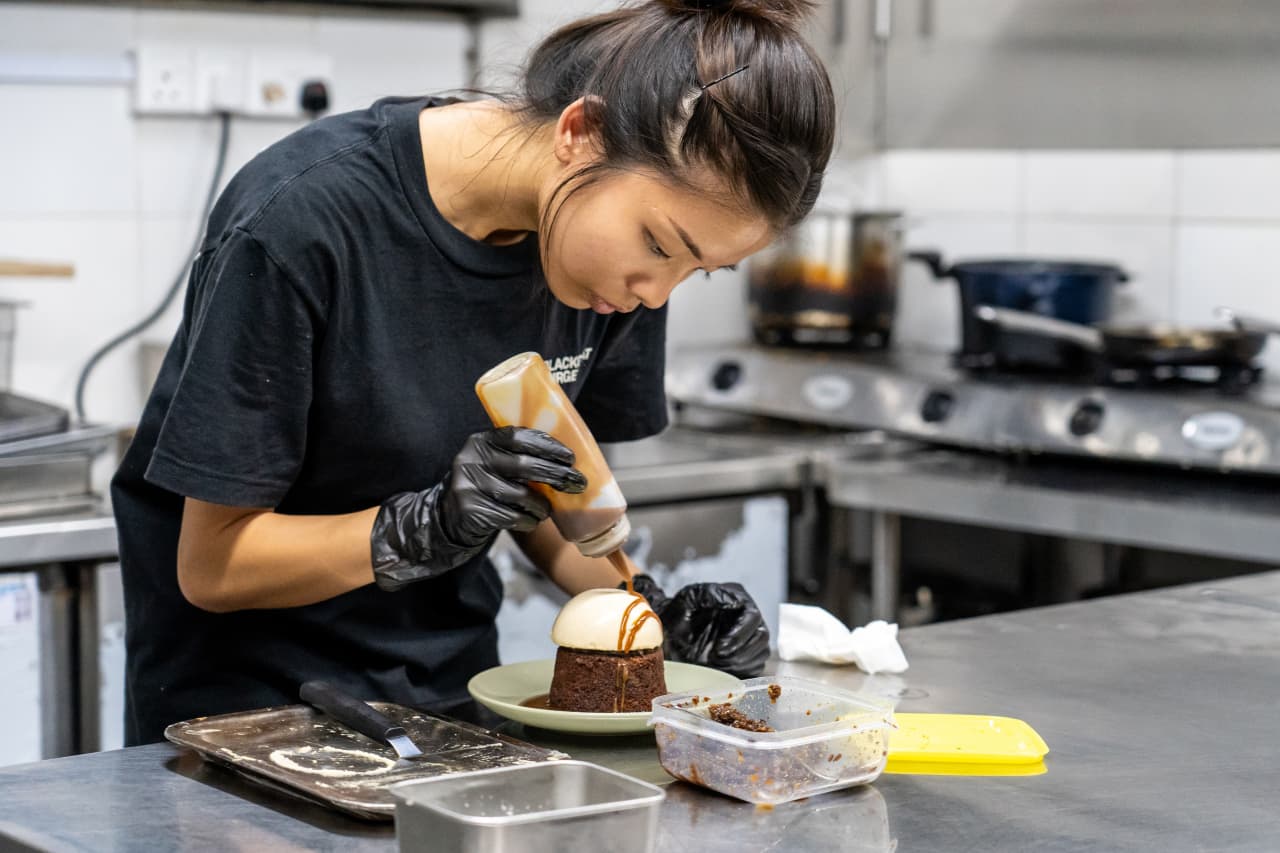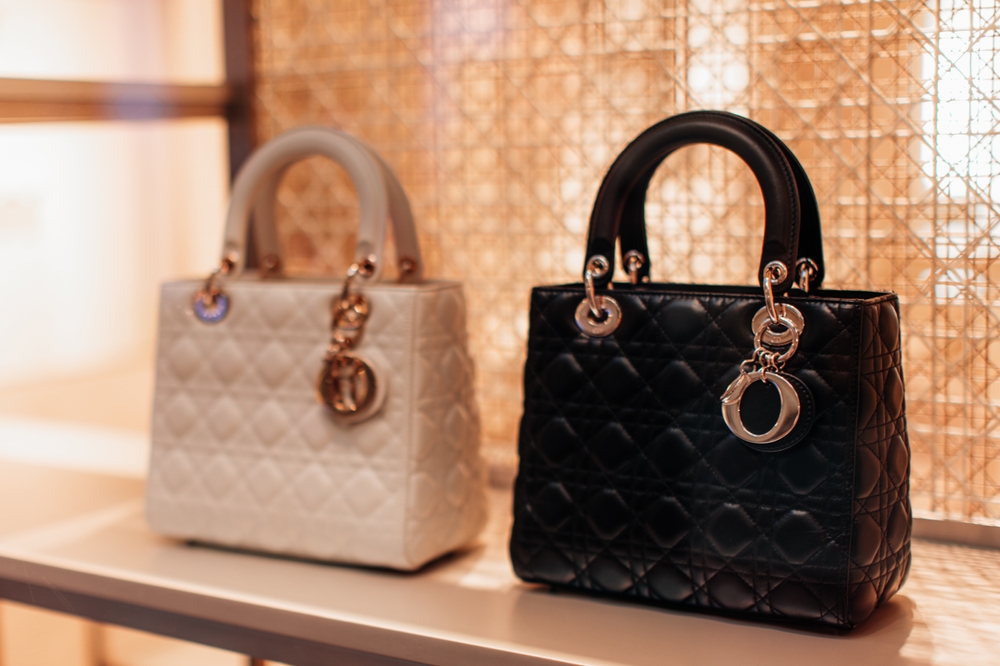Suntory Whisky’s Chief Blender Shinji Fukuyo on Preserving a Legacy
When Shinjiro Torii founded the Yamazaki Distillery in 1923, few would have been able to forecast the enormous force his company, Suntory Whisky, would go on to become a century later.
Over the past decade in particular, Japanese whisky has evolved from a curiosity known only to connoisseurs into a powerhouse beloved in every corner of the whisky world. As chief blender for Suntory Whisky, Shinji Fukuyo has spearheaded this modern surge, and enjoys a unique position as the House of Suntory celebrates its 100-year anniversary.
“Witnessing the global impact of Suntory whiskies brings me great personal fulfilment and fuels my passion for creating beloved whiskies for everyone to enjoy,” Fukuyo says. Over the 100 years the company has been producing whisky, he is only the fifth person to hold the title of chief blender. He was named to the position in 2009 after an extensive history working for the company at the Yamazaki Distillery, Japan’s first whisky distillery.
Suntory has been hosting a year of celebrations in honour of its centennial, the highlight of which has been the release of a suite of Centennial Limited Edition whiskies. The lineup includes Yamazaki 18-year-old Mizunara (US$1,500), Hakushu 18-year-old Peated Malt (US$1,200), and a centennial bottling of Hibiki 21-year-old (US$5,000). Each of the three was blended by Fukuyo to showcase a unique flavour profile and characteristic that stands apart from its typical bottlings. The Yamazaki and Hakushu whiskies were released this May, while the Hibiki debuted in a separate release last month.

House of Suntory
Another component of this year’s ongoing Suntory centennial fete was the Sofia Coppola directed Suntory Time tribute film, as well as the Roman Coppola directed docuseries, The Nature and Spirit of Japan, both of which starred Keanu Reeves. Elsewhere around Japan, other prominent businesses have been getting in on the fun as well. For instance, a 30-minute drive from the Yamazaki Distillery, Hotel the Mitsui Kyoto’s signature restaurant Toki—which happens to share the name of a Suntory Whisky product—has unveiled an elaborate Hibiki whisky pairing dinner, while its Garden Bar has offered an exclusive menu of Hibiki cocktails.
Fukuyo spoke with Penta about the century-long legacy of the House of Suntory, as well as the creation of this year’s honorary Centennial Limited Edition whisky releases.
Penta: What does this special occasion signify for you?
Shinji Fukuyo: Shinjiro Torii’s legacy began with a dream to create an original whisky that would suit the delicate palate of the Japanese consumers that is blessed with the riches of Japanese nature and craftsmanship. As chief blender, I am dedicated to upholding Suntory’s rich legacy and traditions, while expressing our craftsmanship through the whiskies that my team and I create.
As Japanese whisky has soared in popularity over the past decade, what are the qualities that define Suntory’s whiskies and have helped make them so special for drinkers around the world?
We use high-quality natural water, which has been nurtured over many years, to produce a delicate spirit. The natural environment and climate of where our distilleries sit in Japan also influences our whiskies. Our climate highlights the dynamic changes of the four seasons, including humid, hot summers and dry, cold winters to give our whisky a deep sense of maturity.
The quality of whisky is showcased in the flavour and aroma that is developed over time by producing a rich distillate from good raw materials and placing it in high-quality casks. Also, to bring out the harmony of flavour and aroma, we carefully proceed and blend various types of whiskies in a skilful balance, which I believe embodies the delicate Japanese craftsmanship.
What was your approach with this year’s limited-edition whiskies?
The existing Yamazaki 18-year is a product that combines American oak, Spanish oak, Mizunara oak, and smoky Yamazaki malt to express complexity while highlighting the character of Spanish oak. On the other hand, the limited-edition Yamazaki 18-year-old Mizunara uses only malt whiskies aged in Mizunara barrels for a minimum of 18 years and features cinnamon and nutmeg aromas, with undertones of Japanese incense, sandalwood, and dry coconut emphasised in the finish, with subtle spices.
For Hakushu, both our existing Hakushu 18-year-old and the limited Hakushu 18-year-old Peated Malt are blended with various whiskies aged in Hakushu, including American and Spanish oak, heavy peated and non-peated, for a smoky yet fruity and sweet finish. The limited edition is balanced with several peated Hakushu malt whiskies aged in American oak for over 18 years to produce a fresh and crisp smoky taste.

House of Suntory
Looking ahead to the next few decades, how do you envision Suntory continuing to evolve? How about Japanese whisky as a category on the whole?
For these 100 years, we have been striving to create a culture where Japanese consumers can enjoy whisky. These are values we still prioritise today, as our team is constantly in the pursuit of enhancing our quality and craftsmanship. As we look to the future, we have seen a growing global interest in Japanese products and believe that there are further opportunities to spread the excellence of Suntory Whisky throughout the world.
This interview has been edited for length and clarity.
 Copyright 2020, Dow Jones & Company, Inc. All Rights Reserved Worldwide. LEARN MORE
Copyright 2020, Dow Jones & Company, Inc. All Rights Reserved Worldwide. LEARN MORE
This stylish family home combines a classic palette and finishes with a flexible floorplan
Just 55 minutes from Sydney, make this your creative getaway located in the majestic Hawkesbury region.
No trip to Singapore is complete without a meal (or 12) at its hawker centres, where stalls sell multicultural dishes from generations-old recipes. But rising costs and demographic change are threatening the beloved tradition.
In Singapore, it’s not unusual for total strangers to ask, “Have you eaten yet?” A greeting akin to “Good morning,” it invariably leads to follow-up questions. What did you eat? Where did you eat it? Was it good? Greeters reserve the right to judge your responses and offer advice, solicited or otherwise, on where you should eat next.
Locals will often joke that gastronomic opinions can make (and break) relationships and that eating is a national pastime. And why wouldn’t it be? In a nexus of colliding cultures—a place where Malays, Indians, Chinese and Europeans have brushed shoulders and shared meals for centuries—the mix of flavours coming out of kitchens in this country is enough to make you believe in world peace.
While Michelin stars spangle Singapore’s restaurant scene , to truly understand the city’s relationship with food, you have to venture to the hawker centres. A core aspect of daily life, hawker centres sprang up in numbers during the 1970s, built by authorities looking to sanitise and formalise the city’s street-food scene. Today, 121 government-run hawker centres feature food stalls that specialise in dishes from the country’s various ethnic groups. In one of the world’s most expensive cities, hawker dishes are shockingly cheap: A full meal can cost as little as $3.
Over the course of many visits to Singapore, I’ve fallen in love with these places—and with the scavenger hunts to find meals I’ll never forget: delicate bowls of laksa noodle soup, where brisk lashes of heat interrupt addictive swirls of umami; impossibly flaky roti prata dipped in curry; the beautiful simplicity of an immaculately roasted duck leg. In a futuristic and at times sterile city, hawker centres throw back to the past and offer a rare glimpse of something human in scale. To an outsider like me, sitting at a table amid the din of the lunch-hour rush can feel like glimpsing the city’s soul through all the concrete and glitz.
So I’ve been alarmed in recent years to hear about the supposed demise of hawker centres. Would-be hawkers have to bid for stalls from the government, and rents are climbing . An upwardly mobile generation doesn’t want to take over from their parents. On a recent trip to Singapore, I enlisted my brother, who lives there, and as we ate our way across the city, we searched for signs of life—and hopefully a peek into what the future holds.
At Amoy Street Food Centre, near the central business district, 32-year-old Kai Jin Thng has done the math. To turn a profit at his stall, Jin’s Noodle , he says, he has to churn out at least 150 $4 bowls of kolo mee , a Malaysian dish featuring savoury pork over a bed of springy noodles, in 120 minutes of lunch service. With his sister as sous-chef, he slings the bowls with frenetic focus.
Thng dropped out of school as a teenager to work in his father’s stall selling wonton mee , a staple noodle dish, and is quick to say no when I ask if he wants his daughter to take over the stall one day.
“The tradition is fading and I believe that in the next 10 or 15 years, it’s only going to get worse,” Thng said. “The new generation prefers to put on their tie and their white collar—nobody really wants to get their hands dirty.”
In 2020, the National Environment Agency , which oversees hawker centres, put the median age of hawkers at 60. When I did encounter younger people like Thng in the trade, I found they persevered out of stubbornness, a desire to innovate on a deep-seated tradition—or some combination of both.
Later that afternoon, looking for a momentary reprieve from Singapore’s crushing humidity, we ducked into Market Street Hawker Centre and bought juice made from fresh calamansi, a small citrus fruit.
Jamilah Beevi, 29, was working the shop with her father, who, at 64, has been a hawker since he was 12. “I originally stepped in out of filial duty,” she said. “But I find it to be really fulfilling work…I see it as a generational shop, so I don’t want to let that die.” When I asked her father when he’d retire, he confidently said he’d hang up his apron next year. “He’s been saying that for many years,” Beevi said, laughing.
More than one Singaporean told me that to truly appreciate what’s at stake in the hawker tradition’s threatened collapse, I’d need to leave the neighbourhoods where most tourists spend their time, and venture to the Heartland, the residential communities outside the central business district. There, hawker centres, often combined with markets, are strategically located near dense housing developments, where they cater to the 77% of Singaporeans who live in government-subsidised apartments.
We ate laksa from a stall at Ghim Moh Market and Food Centre, where families enjoyed their Sunday. At Redhill Food Centre, a similar chorus of chattering voices and clattering cutlery filled the space, as diners lined up for prawn noodles and chicken rice. Near our table, a couple hungrily unwrapped a package of durian, a coveted fruit banned from public transportation and some hotels for its strong aroma. It all seemed like business as usual.
Then we went to Blackgoat . Tucked in a corner of the Jalan Batu housing development, Blackgoat doesn’t look like an average hawker operation. An unusually large staff of six swirled around a stall where Fikri Amin Bin Rohaimi, 24, presided over a fiery grill and a seriously ambitious menu. A veteran of the three-Michelin-star Zén , Rohaimi started selling burgers from his apartment kitchen in 2019, before opening a hawker stall last year. We ordered everything on the menu and enjoyed a feast that would astound had it come out of a fully equipped restaurant kitchen; that it was all made in a 130-square-foot space seemed miraculous.
Mussels swam in a mushroom broth, spiked with Thai basil and chives. Huge, tender tiger prawns were grilled to perfection and smothered in toasted garlic and olive oil. Lamb was coated in a whisper of Sichuan peppercorns; Wagyu beef, in a homemade makrut-lime sauce. Then Ethel Yam, Blackgoat’s pastry chef prepared a date pudding with a mushroom semifreddo and a panna cotta drizzled in chamomile syrup. A group of elderly residents from the nearby towers watched, while sipping tiny glasses of Tiger beer.
Since opening his stall, Rohaimi told me, he’s seen his food referred to as “restaurant-level hawker food,” a categorisation he rejects, feeling it discounts what’s possible at a hawker centre. “If you eat hawker food, you know that it can often be much better than anything at a restaurant.”
He wants to open a restaurant eventually—or, leveraging his in-progress biomedical engineering degree, a food lab. But he sees the modern hawker centre not just as a steppingstone, but a place to experiment. “Because you only have to manage so many things, unlike at a restaurant, a hawker stall right now gives us a kind of limitlessness to try new things,” he said.
Using high-grade Australian beef and employing a whole staff, Rohaimi must charge more than typical hawker stalls, though his food, around $12 per 100 grams of steak, still costs far less than high-end restaurant fare. He’s found that people will pay for quality, he says, even if he first has to convince them to try the food.
At Yishun Park Hawker Centre (now temporarily closed for renovations), Nurl Asyraffie, 33, has encountered a similar dynamic since he started Kerabu by Arang , a stall specialising in “modern Malay food.” The day we came, he was selling ayam percik , a grilled chicken leg smothered in a bewitching turmeric-based marinade. As we ate, a hawker from another stall came over to inquire how much we’d paid. When we said around $10 a plate, she looked skeptical: “At least it’s a lot of food.”
Asyraffie, who opened the stall after a spell in private dining and at big-name restaurants in the region, says he’s used to dubious reactions. “I think the way you get people’s trust is you need to deliver,” he said. “Singapore is a melting pot; we’re used to trying new things, and we will pay for food we think is worth it.” He says a lot of the same older “uncles” who gawked at his prices, are now regulars. “New hawkers like me can fill a gap in the market, slightly higher than your chicken rice, but lower than a restaurant.”
But economics is only half the battle for a new generation of hawkers, says Seng Wun Song, a 64-year-old, semiretired economist who delves into the inner workings of Singapore’s food-and-beverage industry as a hobby. He thinks locals and tourists who come to hawker centers to look for “authentic” Singaporean food need to rethink what that amorphous catchall word really means. What people consider “heritage food,” he explains, is a mix of Malay, Chinese, Indian and European dishes that emerged from the country’s founding. “But Singapore is a trading hub where people come and go, and heritage moves and changes. Hawker food isn’t dying; it’s evolving so that it doesn’t die.”
This stylish family home combines a classic palette and finishes with a flexible floorplan
Just 55 minutes from Sydney, make this your creative getaway located in the majestic Hawkesbury region.






















